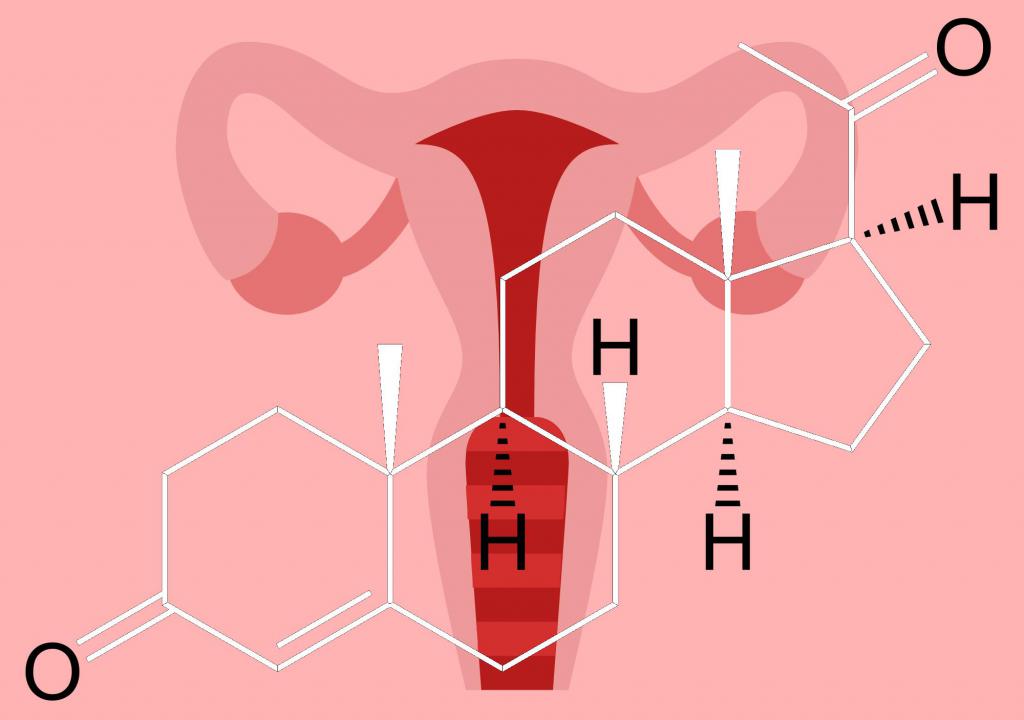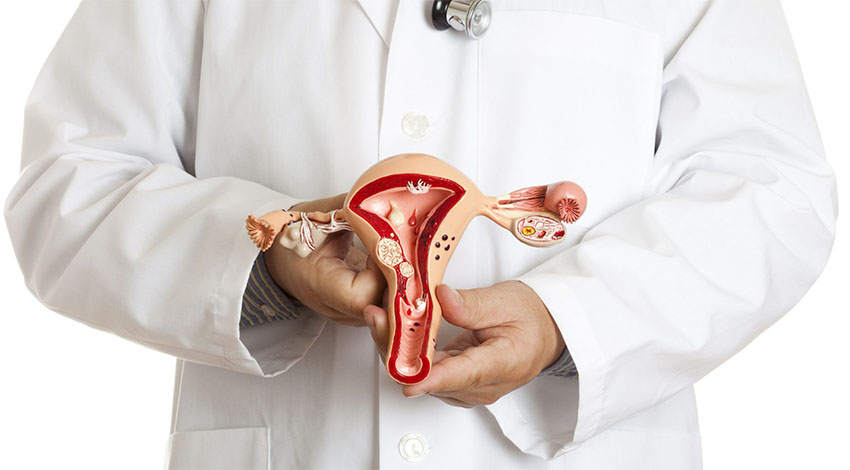In the article, we consider the causes of low progesterone in the luteal phase.
A reduced level of this hormone is considered a symptom of the malfunctioning of the ovaries. This condition is called a luteal phase defect (DLF) in medicine. An insufficient level of progesterone in this period contributes to the creation of negative conditions on the surface of the inner layer of the uterus for implantation of a fetal egg into it. In view of this, even in the event of fertilization, a woman’s menstruation will occur.

This is dangerous low progesterone in the luteal phase.
Basic concepts
This phase begins in the second part of the menstrual cycle and lasts about 14 days after the onset of ovulation, immediately after which the corpus luteum forms. It is responsible for the production of progesterone, which is necessary until the placenta begins to form. If fertilization does not occur, the woman begins menstruation. In some cases, the cycle changes due to the low concentration of the hormone. The main reasons for this phenomenon should be determined by a specialist.
What is the rate of progesterone in the luteal phase?
Within normal limits, the level of the hormone varies from 7.0 to 56.5 nmol / L. If the concentration of the hormone is below this indicator, we are talking about its insufficiency.
Consider the main causes of low progesterone in the luteal phase.
Reasons for development
The production of progesterone by the corpus luteum is necessary for the normal process of implantation and embryo formation. But sometimes the production of this hormone decreases, due to a number of possible reasons.
If low progesterone is detected in the luteal phase of the menstrual cycle, it is necessary to conduct an appropriate diagnosis, which will reveal abnormalities in the hormonal background. Perhaps the patient produces this hormone in a normal amount, however, the mucous membrane of the uterus does not respond correctly to it. In other words, DLF is a pathological phenomenon in which the uterine endometrium does not develop correctly. Because of this, in the luteal phase, the level of progesterone decreases, which creates an obstacle for the fetal egg, preventing it from successfully implanting.

A number of factors are known that can cause abnormal progesterone production processes and provoke the development of luteal phase dysfunctions. They can be divided into three main categories: organic, functional and iatrogenic.
So, we will first analyze the functional causes of low progesterone in the luteal phase.
Functional reasons
The list of functional causes that can reduce the production of progesterone include conditions due to impaired reproductive system functions. The main factors in this are:
- Savage Syndrome. This condition is characterized by the cessation of menstruation and the occurrence of infertility in women under 35 years of age. In this case, the ovaries lose their sensitivity to sex hormones, which stimulate the production of eggs. A similar disease manifests itself as a prolonged violation of menstrual functions. Hormone therapy is needed to help restore menstruation and the production of progesterone for conception.
- Ovarian hypertrophy syndrome - the absence of menstrual bleeding due to the medical effect on the suppression of gonadotropic functions of the ovaries. What else can trigger very low progesterone in the luteal phase?
- Stein-Leventhal syndrome, which is accompanied by irregularity or lack of ovulation, increased production of estrogen, which inhibits the production of progesterone.
- Ovarian Depletion Syndrome. These organs, due to a number of factors, begin to function incorrectly, resulting in the onset of premature menopause.
- Hypothyroidism, which is a pathological condition that occurs due to insufficiency of hormones produced by the thyroid gland. With the secondary type of this disease, the hypothalamic-pituitary structure is affected. The reasons for the low levels of progesterone in the luteal phase can be difficult to determine.
- Pituitary hypogonadism, which is a syndrome characterized by a lack of functioning of the gonads with impaired hormone production. Therapy of this pathology is based on the use of hormone replacement treatment.
- Hyperprolactinemia, which is caused by increased levels of the pituitary hormones, in particular, prolactin. In women with a similar diagnosis, menstrual irregularities are noted, infertility develops.
The above reasons can provoke a decrease in the concentration of progesterone in LF. The consequence of this is a violation of the ovulatory phase and reproductive function.
What other causes of low luteal progesterone are known?

Organic reasons
These reasons are due to pathologies of the organs of the reproductive and other systems, which are able to influence the structure and functioning of the uterus. These include:
- uterine fibroids;
- Asherman's syndrome;
- endometrial hyperplasia;
- cancer of the uterus;
- cirrhosis and hepatitis;
- endometritis.
With synechiae inside the uterus, hypomenstrual syndrome or secondary amenorrhea can occur. Intrauterine synechia does not allow the fetal egg to attach to the endometrium, therefore, conception becomes impossible at the same time.
The likelihood of becoming pregnant decreases with the development of endometrial hyperplasia. The disease causes malfunctions of the menstrual cycle, resulting in a lower level of progesterone in the LF.
Iatrogenic causes
Iatrogenic factors include conditions that are caused by therapeutic measures. Gynecological cleansing is performed to establish the cause of irregular periods, prolonged and heavy bleeding with myoma, hyperplasia, polyps. In this case, the specialist can disrupt the structure of the endometrium, after which synechia is formed, contributing to an imbalance of the hormonal background in the LF.
Termination of pregnancy also entails similar hormonal problems. In order to restore it, hormone replacement therapy is often required. In some patients, progesterone levels decrease, which becomes a factor in the development of infertility. Fertility after such manipulations is restored gradually, with the help of proper organized medication.

Yellow body
Despite the fact that doctors have not yet fully studied the syndrome of a decrease in progesterone during LF, they are very confident that the main cause of this pathological condition is an abnormal corpus luteum or endometrial structure.
The corpus luteum, whose functions are impaired, for some reason is not able to function correctly, which leads to insufficient production of progesterone by it. A number of factors are known that are responsible for the insufficient functionality of the corpus luteum or its absence. These include:
- Improper follicular development. Since the corpus luteum is formed from the same cells that make up the dominant follicle, its functioning may be impaired. Follicle formation can be disrupted due to various factors, including lack of nutrients, an excess of free radicals, and changes in metabolism.
- Hormone levels. For the proper process of follicle maturation, a special balance in the concentration of hormones is necessary. Abnormalities of the hormonal background can disrupt the formation of follicles, the corpus luteum and the process of ovulation.
- Circulation. The processes of proper functioning of the corpus luteum are influenced by the nature of blood flow. Anomalies in the formation of blood vessels and circulatory disorders are closely associated with the formation of the corpus luteum during the luteal phase, and this reason has been proved by numerous studies.
- Abnormal reactions of the uterus to progesterone. Despite the normal production of progesterone, endometrial defects do not allow it to respond to this hormone. This leads to a violation of the formation of the uterine lining, which becomes an obstacle to implantation of the embryo.

Symptoms of pathology
A low concentration of progesterone in the luteal phase is found to be quite difficult, especially in cases where a woman does not plan to conceive, does not undergo laboratory diagnosis, and tries to become pregnant without medical intervention. Many do not even suspect about such a diagnosis, since they do not know the features of the menstrual cycle. Symptoms of low progesterone in the luteal phase are:
- problems with conception;
- spontaneous miscarriages in the early stages;
- shortened menstrual cycles (less than 24 days);
- frequent episodes of premenstrual syndrome;
- ovulation that occurs earlier than the prescribed time.
In the second phase, a woman should not experience pain, bleeding, or diarrhea. If such signs are worrying, difficulties with conception are found, then it is recommended to undergo an examination.
How to detect low levels of progesterone in the luteal phase?
Diagnostics
Due to a lack of understanding of pathophysiology and the lack of a unified diagnostic technique for this pathological phenomenon, its treatment is usually difficult. During a diagnostic examination, the specialist initially collects an anamnesis, which should include the following information:
- medical history;
- patient complaints;
- features of menstrual functions;
- obstetric and gynecological history.
- features of living conditions;
- regularity of sexual intercourse.

Attention is also paid to the ratio of weight and height, the distribution of adipose tissue, body hair. Within a month, the patient is recommended to measure the basal temperature so that the specialist can correctly assess the onset of the luteal phase and ovulation.
Gynecological examination, ultrasound examination are also carried out. A prerequisite for adequate diagnosis is laboratory testing to determine the production of luteinizing and follicle-stimulating hormones, progesterone, estrogen, inhibin, 17-OH progesterone, TSH, testosterone.
In addition, you will need to donate blood to a coagulogram, to make a biochemical analysis.
So, in a woman, progesterone is below normal in the luteal phase. Treatment should be immediate.
Therapeutic measures
The main goal of therapy for such a pathology is to improve the quality of the corpus luteum and follicle, reduce the degree of oxidation and increase the level of progesterone. To do this, all necessary therapeutic measures are carried out, which include some gynecological instrumental interventions (if necessary), for example, hysteroscopy, drug treatment in case of existing inflammatory processes in the reproductive system, hormonal therapy to correct the hormonal background. The correction methods directly depend on the values of progesterone, the severity of a decrease in its level, the concentration of other sex hormones is taken into account.
Recommendations to patients
It is very important not only to undergo the correct treatment with low progesterone in the luteal phase, but also to observe the following recommendations:

- Healthy diet. Food should include whole foods, a large amount of high-quality protein, fats, lots of fruits and vegetables. Women are advised to drink plenty of water and exclude alcohol, caffeine and sugar.
- Avoid stress. In the luteal phase, a decrease in progesterone may be associated with prolonged or chronic stress. In this case, the body needs more progesterone to produce cortisol. This leads to the fact that during the LF period, progesterone is not enough to carry out its direct functions.
- The use of medications that help normalize the functioning of the adrenal glands and glands producing cortisol, which can also be useful in increasing progesterone levels and stabilizing the luteal phase.
- Specialists recommend using special supplements to maintain progesterone: Wild Yam, Vitex, Melatonin and Vitamin B6.
- Elimination of genital infections and inflammatory processes in the appendages and uterus. This is done by taking antibacterial drugs.
- Compliance with hygiene and the rules of intimate life. A woman is recommended to have a regular sexual life with a constant sexual partner, which will help to avoid many serious consequences in the form of infection with sexual infections and disturbance of the vaginal microflora.
Standard therapy for progesterone below normal in the luteal phase is based on the use of medications. Vitamin complexes, the use of antiestrogens, the use of chorionic gonadotropin preparations, follitropins - all this is recommended to be done simultaneously. Comprehensive treatment can increase progesterone and prevent such serious consequences of this condition as infertility, miscarriage, placental insufficiency, cancer of the endometrium and mammary gland, the formation of polyps and myomas.